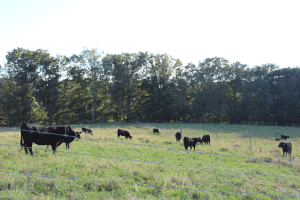Weaner Cattle Need Their Own Trainer
– Kirsten Nickles MSc and Anthony Parker PhD, The Ohio State University Department of Animal Sciences

The addition of a social facilitator cow seems to reduce the negative walking behaviors associated with weaning.
The most common weaning method in the United States beef industry is the abrupt removal of calves from cows at 5-8 months of age (Enríquez et al., 2011). Natural weaning in beef cattle however, occurs later in life for a calf at 7-14 months of age (Reinhardt and Reinhardt, 1981). The immediate cessation of milk supply and complete maternal separation causes calves to exhibit stereotypical behaviors such as walking and vocalizing at weaning. Calves will engage in these stereotypical behaviors for three to four days and the excessive activity and lack of feed intake result in body weight loss and fatigue (Weary et al., 2008). The anxiety and frustration experienced at weaning by the calf are critical factors that negatively affect the growth rate of the calf and can contribute to the onset of disease such as bovine respiratory disease. This is why we should aim to manage calves in a way that reduces these negative stereotypical weaning behaviors.
The use of a “trainer cow” or “social facilitator” has been proposed as a method to reduce negative stereotypical weaning behaviors such as walking, and increase calf eating behavior during weaning. Cattle are gregarious animals, thus a further source of stress for calves at weaning is the removal from the hierarchical structure provided by the herd they were raised in. In this cow-calf hierarchy, the brood cows are the dominant figures in which calves follow and model their behaviors. Therefore, it has been proposed that using mature animals as “trainer animals” or “social facilitators” will have positive effects on body weight gain, health, and behavior of feedlot calves (Loerch and Fluharty, 2000). The reported results on the efficacy of trainer cows is equivocal. Loerch and Fluharty (2000) completed several trials evaluating the effect of both trainer cows and steers on calf performance, health, and behavior. It was reported that the use of feedlot adapted trainer steers was not beneficial. Alternatively, the authors did discover that in some of the studies, trainer cows had positive short-term effects on average daily gain, morbidity, and eating behaviors of calves. While these effects were short-term, the authors speculated that the effects were sufficient in moderating stress and making the transition into the feedlot less difficult for calves. Schwartzkopf-Genswein et al. (1997), however, reported that while trainer cows did alter calf eating behavior in the feedlot, they did not observe an effect on body weight gain or the health status of calves. Additionally, Gibb et al. (2000) found negative consequences of using trainer cows as they observed calves penned with mature cows lying less frequently and appearing to avoid the cow at the feed bunk.
More recently, research has been conducted at The Ohio State University’s Jackson and Eastern Agricultural Research Stations evaluating the effect of a social facilitator cow on walking behaviors in calves abruptly weaned on pasture. We found that the addition of a social facilitator decreased the total distances walked on the day of weaning by calves placed with a social facilitator compared to control calves abruptly weaned on pasture without a social facilitator (7.19 km compared with 9.02 km, respectively). The calves weaned with a social facilitator also devoted less time to walking on the day of weaning compared with control calves (2.46 hours compared with 3.14 hours, respectively). While negative stereotypical walking behaviors were decreased in calves placed with a social facilitator, there were no observable differences in calf body weight.
Therefore, the addition of a social facilitator seems to reduce the negative walking behaviors associated with weaning, however, results when a social facilitator or trainer cow was used in a feedlot are equivocal. The difference between studies may be due to environmental factors and/or experimental design. As an alternative weaning method, the use of a trainer cow is a non-invasive, non-labor intensive management strategy that is a viable option for producers to implement. This method can easily be done in both pasture and feedlot settings, depending on what a producer has available. This is also an ideal weaning method if a cull cow is used as the “trainer cow”, as it is an easy way to supplement the cull cow and add body condition before marketing the trainer cow.
There are, however, considerations that should be made prior to using a trainer cow as an alternative weaning method. Allow the trainer cow and a friend access to the weaning paddock for three days before the calves are weaned and placed with her. All cattle display exploratory behaviors when placed in a new area but these behaviors will decrease after 48 hours. If a cull cow or non-pregnant cow is used as the “trainer cow”, producers must control the cow’s estrus cycle to prevent her from displaying estrus at weaning as this can increase walking behaviors in calves, especially bull and steer calves. If weaning calves in a feedlot, or if supplementing calves and the trainer cow on pasture, producers must provide enough bunk space such that calves are not intimidated by the trainer cow at the bunk. If insufficient bunk space is provided, the mature trainer cow may intimidate calves from coming up to the bunk, and could negatively impact eating behaviors.


